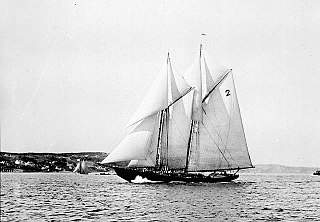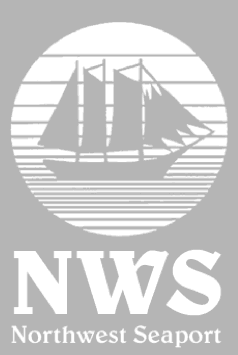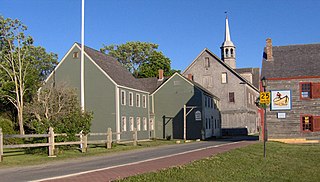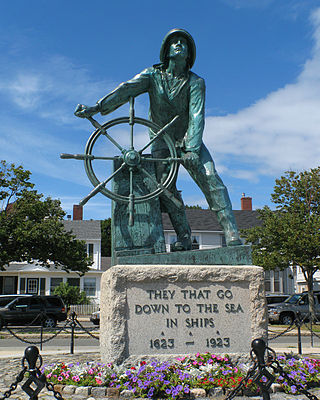
A dory is a small, shallow-draft boat, about 5 to 7 metres or 16 to 23 feet long. It is usually a lightweight boat with high sides, a flat bottom and sharp bows. It is easy to build because of its simple lines. For centuries, the dory has been used as a traditional fishing boat, both in coastal waters and in the open sea.

Bluenose was a fishing and racing gaff rig schooner built in 1921 in Lunenburg, Nova Scotia, Canada. A celebrated racing ship and fishing vessel, Bluenose under the command of Angus Walters, became a provincial icon for Nova Scotia and an important Canadian symbol in the 1930s, serving as a working vessel until she was wrecked in 1946. Nicknamed the "Queen of the North Atlantic", she was later commemorated by a replica, Bluenose II, built in 1963. The name Bluenose originated as a nickname for Nova Scotians from as early as the late 18th century.

Mahone Bay is a town on the northwest shore of Mahone Bay along the South Shore of Nova Scotia in Lunenburg County. A long-standing picturesque tourism destination, the town has recently enjoyed a growing reputation as a haven for entrepreneurs and business startups. The town has the fastest growing population of any municipality in Nova Scotia according to the 2016 census, experiencing 9.9% population growth.

Northwest Seaport Maritime Heritage Center is a nonprofit organization in Seattle, Washington dedicated to the preservation and interpretation of Puget Sound and Northwest Coast maritime heritage, expressed through educational programs and experiences available to the public aboard its ships. The organization owns three large historic vessels docked at the Historic Ships' Wharf in Seattle's Lake Union Park; the tugboat Arthur Foss (1889), Lightship 83 Swiftsure (1904), and the halibut fishing schooner Tordenskjold (1911). These vessels are used as platforms for a variety of public programs, ranging from tours and festivals to restoration workshops and vocational training.

The Swampscott dory is a traditional fishing boat, used during the middle of the 19th century by fishing villages along the North Shore coast of Massachusetts centered on Swampscott. It is designed to be launched off the beach. The rounded hull provides more buoyancy for launching through surf than the slab sided banks dory. The flat bottom allows the boat to sit upright on the beach. The lack of a keel keeps the boat from being grabbed by a wave and allows the boat to pass cleanly through the surf. The boat still heels easily which allows large fish to be rolled into the boat vs having to lift the fish completely up over the gunnel. The Swampscott Dory, a fishing boat still in use throughout the world today, was invented in 1840 by Theophilius Brackett to row and to pull lobster pots. These dories compare favorably with the New Bedford whaleboat and the Gloucester seine boat.

RV Farley Mowat was a long-range, ice class ship. Originally built as a Norwegian fisheries research and enforcement vessel, she was purchased by the Sea Shepherd Conservation Society in Edinburgh, Scotland, in August 1996. Originally named Sea Shepherd III, the name was changed in 1999 to Ocean Warrior, before eventually being renamed in 2002 after Canadian writer Farley Mowat.

Shelburne is a town located in southwestern Nova Scotia, Canada.
F/VAndrea Gail was an American commercial fishing vessel that was lost at sea with all hands during the Perfect Storm of 1991. The vessel and her six-man crew had been fishing the North Atlantic Ocean out of Gloucester, Massachusetts. Her last reported position was 180 mi (290 km) northeast of Sable Island on October 28, 1991. The story of Andrea Gail and her crew was the basis of the 1997 book The Perfect Storm by Sebastian Junger, and a 2000 film adaptation of the same name.
Cape Sable Island, locally referred to as Cape Island, is a small Canadian island at the southernmost point of the Nova Scotia peninsula. It is sometimes confused with Sable Island. Historically, the Argyle, Nova Scotia region was known as Cape Sable and encompassed a much larger area than simply the island it does today. It extended from Cape Negro (Baccaro) through Chebogue.

Bluenose II is a replica of the fishing and racing schooner Bluenose, commissioned by Sidney Culverwell Oland and built in 1963 as a promotional yacht for Oland Brewery. Sidney Oland donated the schooner to Nova Scotia in 1971 and it has since operated as a sailing ambassador and promotional device for Nova Scotia tourism. In honour of her predecessor's record, Bluenose II does not officially race.

Captains Courageous is a 1937 American adventure film directed by Victor Fleming and starring Freddie Bartholomew, Spencer Tracy, Lionel Barrymore and Melvyn Douglas. Based on the 1897 novel of the same name by Rudyard Kipling, the film had its world premiere at the Carthay Circle Theatre in Los Angeles. It was produced by Louis D. Lighton and made by Metro-Goldwyn-Mayer. Filmed in black and white, Captains Courageous was advertised by MGM as a coming-of-age classic with exciting action sequences.

The 1927 Nova Scotia hurricane was the deadliest tropical cyclone striking Canada in the 20th century. The first observed storm of the season, this cyclone developed from a tropical wave over the deep tropics of the Atlantic Ocean on August 18. Initially a tropical storm, it moved west-northwestward and intensified into a Category 1 hurricane on the modern day Saffir–Simpson hurricane wind scale by August 19. The storm intensified significantly over the next few days, and by August 22, it peaked as a Category 3 hurricane with maximum sustained winds of 125 mph (205 km/h). Around that time, the system began curving northwestward and later northward. By August 23, it turned to the north-northeast and then began weakening on August 24. Thereafter, the storm accelerated toward Atlantic Canada. Late on August 24, the hurricane struck near Yarmouth, Nova Scotia, as a Category 2 hurricane, just before becoming extratropical.

Lowell's Boat Shop is a National Historic Landmark at 459 Main Street in Amesbury, Massachusetts.

The Tancook Schooner is a sailing work boat design credited with influencing North American yacht designers and pleasure craft users during the early to mid twentieth century.

Angus James Walters was a sailor and sea captain who skippered Bluenose from 1921 to 1938. Walters captained Bluenose to five international sailing races, and was undefeated for seventeen years.

Sherman Zwicker is a wooden auxiliary fishing schooner built in 1942 at the Smith and Rhuland shipyard, Lunenburg, Nova Scotia. Influenced by the design of the famous Bluenose, Sherman Zwicker was built to fish the Grand Banks. The schooner was built for F. Homer Zwicker of Zwicker and Co. Officially christened in 1942, the F/V Sherman Zwicker is the last operable saltbank fishing vessel in existence.

Richard Moses Murphy (1838–1916) was a well-known schooner captain who sailed out of Gloucester, Massachusetts, during the late 1800s. Some of his experiences as a mariner are detailed in a chapter titled "The Adventures of Captain Richard Murphy" in The Fisherman’s Own Book, published by Proctor Brothers in 1882.
HMCS Reo II was a former rum-running vessel turned military vessel from Meteghan, Nova Scotia. Built in 1931, the ship was used for rum running for five years until Prohibition ended, and was turned into a coastal freighter. She was commissioned during World War II by the Royal Canadian Navy as an auxiliary minesweeper. Declared surplus by the navy in 1945, she was sold to private interests in 1946. Reo II ended up in Lunenburg, Nova Scotia under the care of the Lunenburg Marine Museum Society. In 1984 Reo II was deemed unfit for repair, and was scuttled off Halifax, Nova Scotia in 1985.

The Fog Warning is one of several paintings on marine subjects by the late-19th-century American painter Winslow Homer (1836–1910). Together with The Herring Net and Breezing Up, painted the same year and also depicting the hard lives of fishermen in Maine, it is considered among his best works on such topics.
The FV Flora Alberta was a Canadian auxiliary fishing schooner based out of Lunenburg, Nova Scotia. She was launched in 1941 by Smith and Rhuland, the company's 187th vessel. The managing owner of the vessel was fishing company Adams & Knickle.






















